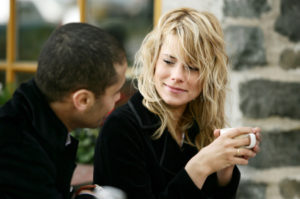 Every act of communication is an act of tremendous courage in which we give ourselves over to two parallel possibilities.
Every act of communication is an act of tremendous courage in which we give ourselves over to two parallel possibilities.
First, the possibility of being seen and understood, and of being accepted.
At the same time we are planting into another mind a seed sprouted in ours, and watching it blossom into a breathtaking flower of mutual understanding says Ursula Kroeber Le Guin in her book The Wave in the Mind
Feeling understood brings along a sense of validation that connects us to the other, and encourages us to share our vulnerabilities which deepens our relationship with the other even more. Honesty and clarity go a long way in fertilizing the soil.
However, in the end, there is always a degree of unpredictability and uncertainty in the climate of communication — even the warmest intention can be met with frost, and disarm the dance of conversation.
That’s where the second possibility comes along: the one of being completely misunderstood, even judged or misperceived, and rejected. Reduced to a withering weed.
And yet, somehow, we long for true connection stemming from truthful communication. We hold these possibilities in both hands and go on surrendering to the beauty and terror of conversation, that ancient human gift.
The most magical and sacred thing is that, whichever the outcome, we end up having transformed one another in this vulnerable-making process of speaking and listening.
Conscious Listening
Conscious listening involves deep and focused listening. It comes from our three centers: the brain, the heart and the gut.
Instead of taking roles listening and speaking, between active subject and passive object, it is a continuous exchange that goes both ways all the time, because listening is not passive. Without active listening, there cannot be real communication.
Thinking about what we are going to say next is not active listening. Active listening is paying full attention to both the words, the message, the gestures, the emotions underlying the words.
That type of listening helps us inhabit the world of the speaker and can transform our relationship with him/her. Out of that type of listening is where understanding and real compassion comes from.
The Energy of Active Listening
Did you know that if you mount two clock pendulums side by side on the wall, they will gradually begin to swing together? They synchronize each other by picking up tiny vibrations they each transmit through the wall.
Any two things that oscillate at about the same interval, if they’re physically near each other, will gradually tend to lock in and pulse at exactly the same interval. Physicists call this mutual phase locking, or entrainment.
We all sense each other’s rhythm. We feel each other’s energy. All living beings are oscillators. We vibrate with each other’s rhythms. There is a kind of synchronization which is an adaptation of our emotions and behavior that can elevate us or bring us down.
Like the two pendulums, two people together can mutually phase-lock. Successful human relationship involves getting in sync. If it doesn’t, the relationship suffers and it may eventually fall apart.
When you speak and you sense the other is truly listening to you, you feel encouraged to share more, to open up. It becomes a shared event.
Mutual honest communication is empowering. The power of each speaker is magnified and expanded by the engagement of the listener.
This is why our words are magic, they transcend time and space. Words are capable of controlling our minds and the minds of others. Words have so much power.  They can bring people down, instill fear and anxiety. However, words can also transform and even inspire others to change themselves and even their lives for the better.
They can bring people down, instill fear and anxiety. However, words can also transform and even inspire others to change themselves and even their lives for the better.
Listening is a skill that we learn and it starts with intention. It is a practice, and like all other practices, it is challenging especially at the beginning. The impulse to talk is seductive, and we usually follow it mindlessly.
I invite you to bring awareness to your listening habits. Notice how your relationships change. As you become a better active listener, you will also become a better partner, a better parent, a better colleague, a better friend.
Visit How to Cultivate the Art of Listening in Our Children
The inspiration to write this blog came to me after reading “Telling Is Listening” found in The Wave in the Mind by Ursula Kroeber Le Guin.
Thanks for this post, dear Mónica!
I will try to be an active listener; it will help me a lot as an interviewer. In fact, one of my favorites activities as a journalist is to make interviews 🙂
Dear Jorge, Thank you for sharing! I’ve noticed that my favorite interviewers are the ones who listen attentively and follow the flow of the conversation, instead of the ones who follow strictly pre-prepared questions. And of course, active listening has everything to do with that.